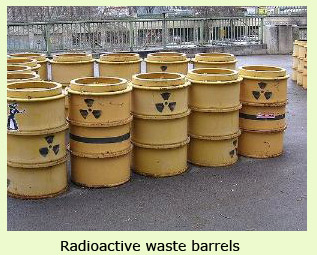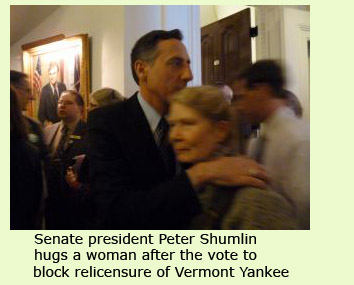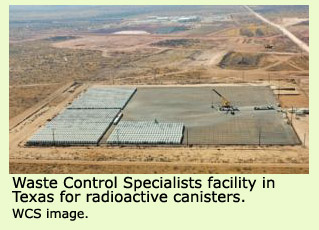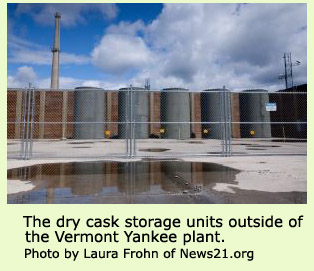Controversial rules for Texas landfill could impact decommissioning of Vermont Yankee
Controversial rules for Texas landfill could impact decommissioning of Vermont Yankee
December 1, 2010
By Anne Galloway
VTDigger.org

New rules under consideration by a Texas commission could hamper the decommissioning of the Vermont Yankee Nuclear Plant in the near future, according to experts and activists who oppose the change.
They say the proposal, which would allow a Texas landfill to accept additional waste from out-of-state entities, including nuclear power companies like Entergy Corp., could give away space that is allotted for anticipated radioactive material from Vermont Yankee.
Texas formed a compact with Vermont in 1998 to establish a permanent repository for low-level radioactive waste generated by nuclear power plants and medical and research facilities in Vermont and Texas. The compact was set up for the two states’ exclusive use. (Maine was originally a part of the agreement but dropped out). In 2009, Waste Control Specialists received a license to open a radioactive waste landfill in West Texas for the compact that is now under construction.
Two weeks ago, members of the Texas Low-Level Radioactive Waste Disposal Compact Commission, including two Douglas administration officials representing Vermont, gave preliminary approval to procedures that would allow the commission to accept applications for permits from entities in other states to dump waste at the site.
Critics say the new rules could transform the landfill into a national repository for low-level nuclear waste and that it could fill up quickly because demand for landfill space is high. Thirty-six states are not currently part of a radioactive waste disposal compact. If the Texas Commission approves the proposed procedures after a 30-day public comment period that ends Dec. 26, the West Texas facility would be the only site of its type licensed to accept waste from anywhere in the country, according to the Nuclear Information and Resource Service, an anti-nuclear group based in Maryland.
Members of the Texas Commission who support the proposals, including Uldis Vanags, the state nuclear engineer for the Vermont Department of Public Service, say they are looking out for Vermont’s interests and that opening the site to "imported" waste from "noncompact" entities will help to pay for the construction of the high-tech facility, which is slated to open at the end of 2011. Otherwise, they say, waste disposal costs for the two compact members, Texas and Vermont, would be prohibitively expensive.
"We will not give up our capacity that we need to fulfill the decommissioning of Vermont Yankee," Vanags said. "The only way (we) would consider importation is if there is surplus capacity."
Vanags said the new rule won’t have an impact on decommissioning Vermont Yankee.
Vanags, the state nuclear engineer, and Steven Wark, director of consumer affairs and public information for the Vermont Department of Public Service – both voted on Nov. 13 to support the rules, which will enable other states to apply for access to the landfill. Vanags and Wark, the only two Vermont representatives on the commission, were among the five commissioners who approved the change; two Texas members dissented.
Several Texas Compact commissioners who cast dissenting votes on the rule have questioned whether "imports" will use up capacity at the facility before Vermont has a chance to move radioactive materials from the decommissioned Vermont Yankee plant to Texas.
The proposed rules, which were promulgated in the Texas Register on Nov. 26, are now subject to a 30-day public comment period, which ends Dec. 27.
The commission is expected to make a final decision soon after the public comment period – before the new Vermont governor, Peter Shumlin, is installed and Vermont lawmakers convene for the 2011 legislative session.

Shumlin, a Democrat, and leaders of his party in the Statehouse, have been critical of Entergy Corp.’s handling of maintenance problems at the nuclear power plant in Vernon, including a transformer fire, the collapse of a cooling tower and radioactive leaks, none of which affected public safety, according to the company and the Nuclear Regulatory Commission. Last year, Gov.-elect Shumlin led the charge, as president pro tem of the Vermont Senate, to nix Entergy’s relicensure effort.
Storage in Vermont, or Texas?
Vermont Yankee is licensed to operate until March 2012. Unless the license is extended, which would appear politically untenable given the Vermont Senate’s decision last year to block Entergy’s bid to relicense the 38-year-old plant for 20 years, the plant will be shut down next year, preparing the way for decommissioning.
At that point, where and how the radioactive waste is stored will become a crucial issue.
Entergy Corp. has proposed keeping the materials on the Vernon site in a system called SAFSTOR for a period of six decades.
Another alternative would be a more accelerated decommissioning process, in which the waste would be sent to the West Texas landfill overseen by the commission and operated by a Dallas-based private company, Waste Control Specialists, according to Arnie Gundersen, a nuclear engineer who is a legislative consultant via Fairewinds Associates, Inc., to the Vermont Legislature’s Joint Fiscal Committee.
The compact legally entitles Vermont under a 15-year license to 20 percent, or 462,000 cubic feet, of the 2.3 million cubic feet at the nuclear waste dump. Under the proposal, however, space could be at a premium at the waste facility if "noncompact" entities are allowed to apply for permits to deposit radioactive materials at the site in Andrews County, Texas, according to Bob Gregory, a member of the commission from Texas.
Requests for waste "importation" would be vetted on a case-by-case basis, according to the published rules.
Waste Control Specialists facility in Texas for radioactive canisters, WCS image
 In 2009, the Compact Commission determined that Vermont and Texas together need a total of 6 million cubic square feet of capacity for the amount of radioactive waste generated by both states.
In 2009, the Compact Commission determined that Vermont and Texas together need a total of 6 million cubic square feet of capacity for the amount of radioactive waste generated by both states.
Gregory, one of the dissenting members, said the commission doesn’t have the staff capacity or financial resources to evaluate applications. (The annual budget of $125,000 covers travel and meeting expenses.) In addition, the subjective nature of the proposed permitting process, he said, could leave the commission vulnerable to lawsuits.
He doesn’t know how the commission will defend itself from legal challenges if the commission says no to one entity and yes to another.
"Waste control specialists, Entergy, Santa Claus – anyone can sue us for not allowing radioactive waste to come in," Gregory said. "What are we going to say if we can’t defend ourselves?"
Entergy, according to a Texas official, would have much to gain if the new landfill rules go through. The Louisiana-based corporation needs a place to put the waste from its fleet of 10 plants around the country. "Opening the Texas facility would allow them to take it from those other plants," Gregory said.
A giveaway?
Gundersen, a consultant for the Legislature, suggested that the Douglas administration supports Entergy’s proposal to put Vermont Yankee in SAFSTOR for 60 years, while the company waits for the decommissioning fund to grow enough to cover the cost of moving the material offsite.
David Coriell, the spokesman for Douglas, wrote in an e-mail that the governor "has said, on many occasions, he believes 60 years is too long."
SAFSTOR, in Gundersen’s view, is not necessary. He said Vermont Yankee could be decommissioned in 10 years, but that scenario is contingent on access to landfill capacity in Texas. There is just enough cubic square footage on the site to accommodate the radioactive waste from the plant.
"There’s a limited amount of land (for radioactive waste disposal) in Texas, and the state is giving away Vermont’s land to 35 other states, which will make it impossible to decommission Vermont Yankee," Gundersen said.
In June 2009, Vanags testified to the Vermont Public Service Board that decommissioning Vermont Yankee would cost less than the $568 million spent on Maine Yankee, even though projections that include the SAFSTOR option have been higher. Vermont Public Radio reported in 2007 that decommissioning Vermont Yankee could cost as much as $1.7 billion. In September of this year, the decommissioning fund was at about $443 million. Entergy is responsible for making sure there is adequate money available for decommissioning.
Gundersen said Vanags’ testimony was based on the assumption that the radioactive waste would be shipped to Texas.
"If Vanags’ testimony under oath is correct, we could complete decommissioning by 2020, (but) he’s giving away the land to which you need to ship it," Gundersen said. "If you give away the land, you force SAFSTOR to occur. With no place to send it, we’re sort of constipated."
Vanags, who voted to publish the rules that will allow other states to apply for access to the landfill, said: "There absolutely will be enough space."

"We will not give up our capacity that we need to fulfill the decommissioning of Vermont Yankee," he said.
In audio testimony, Vanags and Wark voted against amendments to the proposed rules that would have given Compact members first dibs to the landfill and also that would have delayed action and allowed the Texas and Vermont legislatures an opportunity to weigh in on the matter.
"We’re actually under the closing phases of the Douglas administration," Gundersen said. "We’re getting to the point where we, the state of Vermont’s administrative agencies, are actually assisting Entergy, as opposed to looking out for the best interests of the state."
Gregory, a Texas commission member who opposed the adoption of the new rules, said he doesn’t understand why the rule has to be adopted by early January. He suspects the timing has something to do with a changing of the political guard in the Vermont governor’s office.
"What on Earth is the rush?" Gregory said. "It’s rushing to beat a date for when the new governor comes to town. If the commissioners change, then the vote would be 4-4; now it’s 6-2."
The terms for the commissioners from Vermont – Vanags, Wark and their alternate Sarah Hoffman – expire Feb. 28, 2010. Gov.-elect Shumlin, in the interim, will likely appoint a new commissioner for the Department of Public Service, who could in turn name new "exempt" employees, or appointed officials, who would take the place of the three who are now on the commission.
Tom Smith, of Public Citizen, an advocacy group that opposes the landfill, said the commission wants to get the rule rammed through before the Texas and Vermont legislatures have a chance to take action to block it.
"They’re afraid the new governor of Vermont might appoint commissioners that might stand up for the state, as opposed to going along with what the nuclear industry wants," Smith said.
John C. White, vice chair of the commission and a radiation safety officer for the University of Texas Southwestern Medical Center, says nothing of the sort is going on.
"We’ve been talking about this for 16 months," White said of the rule. "We can amend the rule if necessary … I don’t see your new governor as part of this."
The rationale for taking all comers
The facility, which is designed to take radioactive materials such as contaminated clothing, glass, metal, reactor components and sludge, needs a certain amount of waste to cover the fixed costs associated with construction.
White, speaking as commission vice chair, said allowing material from other states into the landfill would lower the operating costs for the compact members tenfold.
Vanags said opening up the site to more entities will keep disposal fees at the site reasonable for Texas and Vermont. The commission hasn’t set fees for "imports," but so far it hasn’t imposed up-front contributions from noncompact waste generators. Vermont will pay $25 million to support construction of the site this year.
"The way to reduce cost per cubic foot is to increase your capacity," Vanags said in contending the only way the commission would consider "imports" would be if there is surplus capacity.
Vanags said before the commission would accept applications, it would conduct an updated study to determine how much capacity would be needed by the two compact states.
"We recognize as a commission we have to have a process (for dealing with requests)," Vanags said. "We’re not opposed to importation. We’re open to it, but as long as our capacity is protected. The facility in the future may be expanded, and they may amend their license. In future, there may be surplus capacity."
White supports expanding the site to accommodate more waste. The limitations now placed on the landfill are under the terms of the current license issued by the Texas Commission on Environmental Quality, White said. The site itself, he believes, could be expanded.
In the meantime, demand is high, White said. Medical waste vendors are already coming in to the state of Texas in anticipation of the facility opening a year from now, he said. Hospitals are having a difficult time disposing of waste used in research and in the treatment of cancer, he said.
"So many people say you’re opening the door," White said. "The door is already open. Waste is already coming in to Texas, and we don’t have control over where the waste is stored. We don’t have procedures to say you can’t bring it in."
CLARIFICATION: The following sentence was added to the story, 11:20 a.m. Dec. 2, 2010: David Coriell, the spokesman for Douglas, wrote in an e-mail that the governor "has said, on many occasions, he believes 60 years is too long."
This document contains copyrighted material whose use has not been specifically authorized by the copyright owner. SEED Coalition is making this article available in our efforts to advance understanding of ecological sustainability, human rights, economic democracy and social justice issues. We believe that this constitutes a "fair use" of the copyrighted material as provided for in section 107 of the US Copyright Law. If you wish to use this copyrighted material for purposes of your own that go beyond "fair use", you must obtain permission from the copyright owner.


